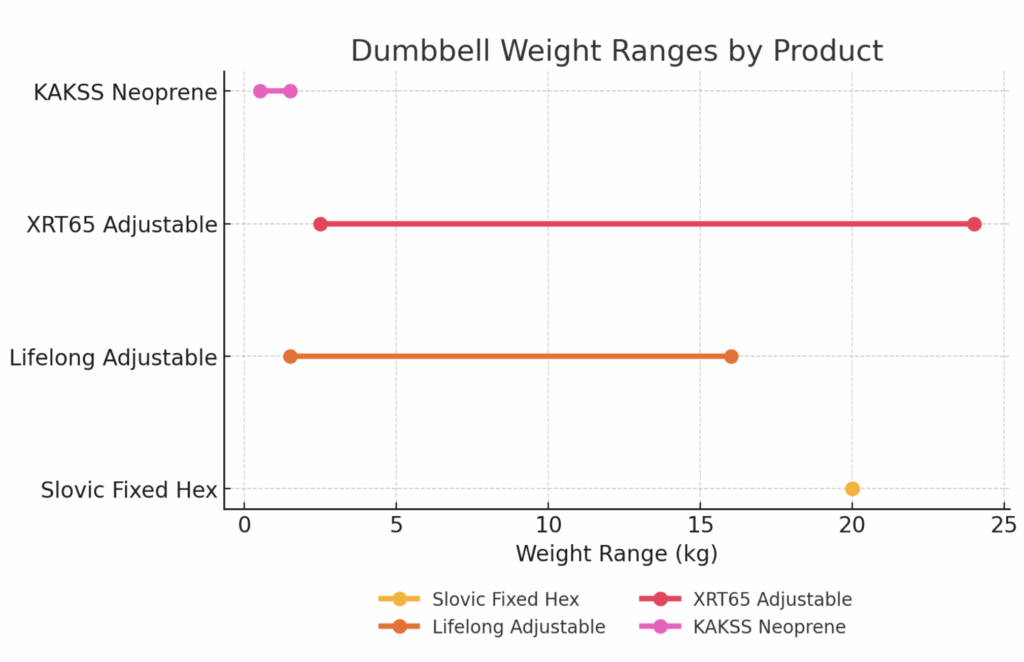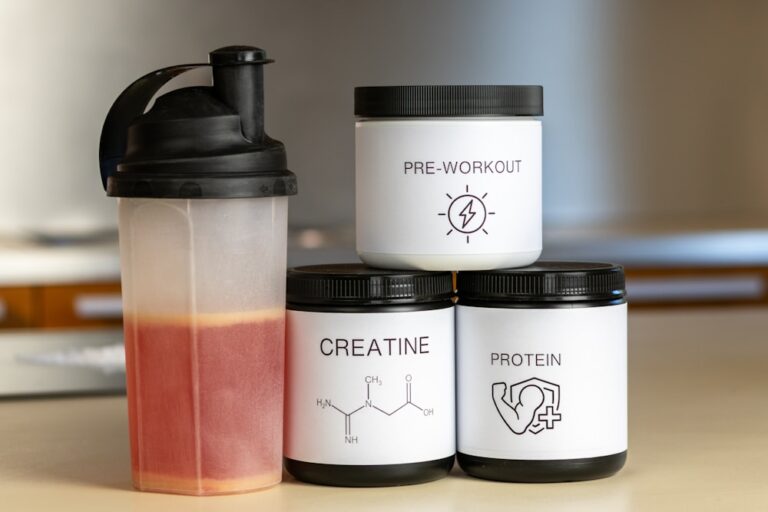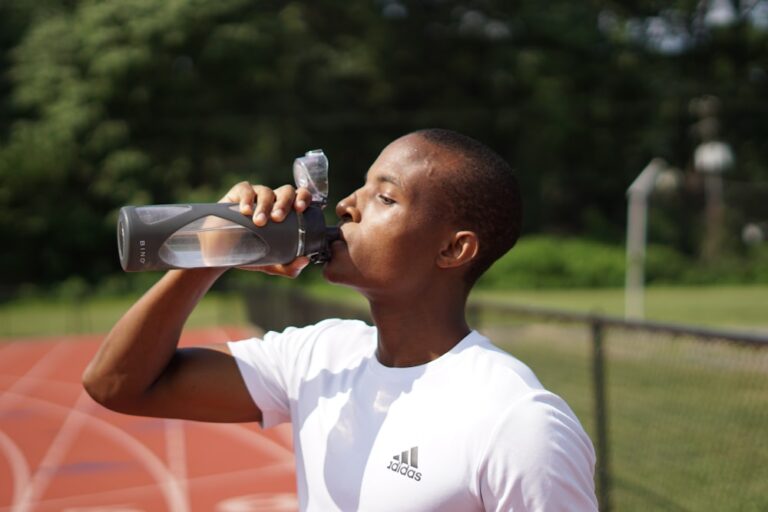
Elegance in Rebellion.
Own the Edge.
Fixed vs Adjustable Dumbbells: What I Learned After Trying Both
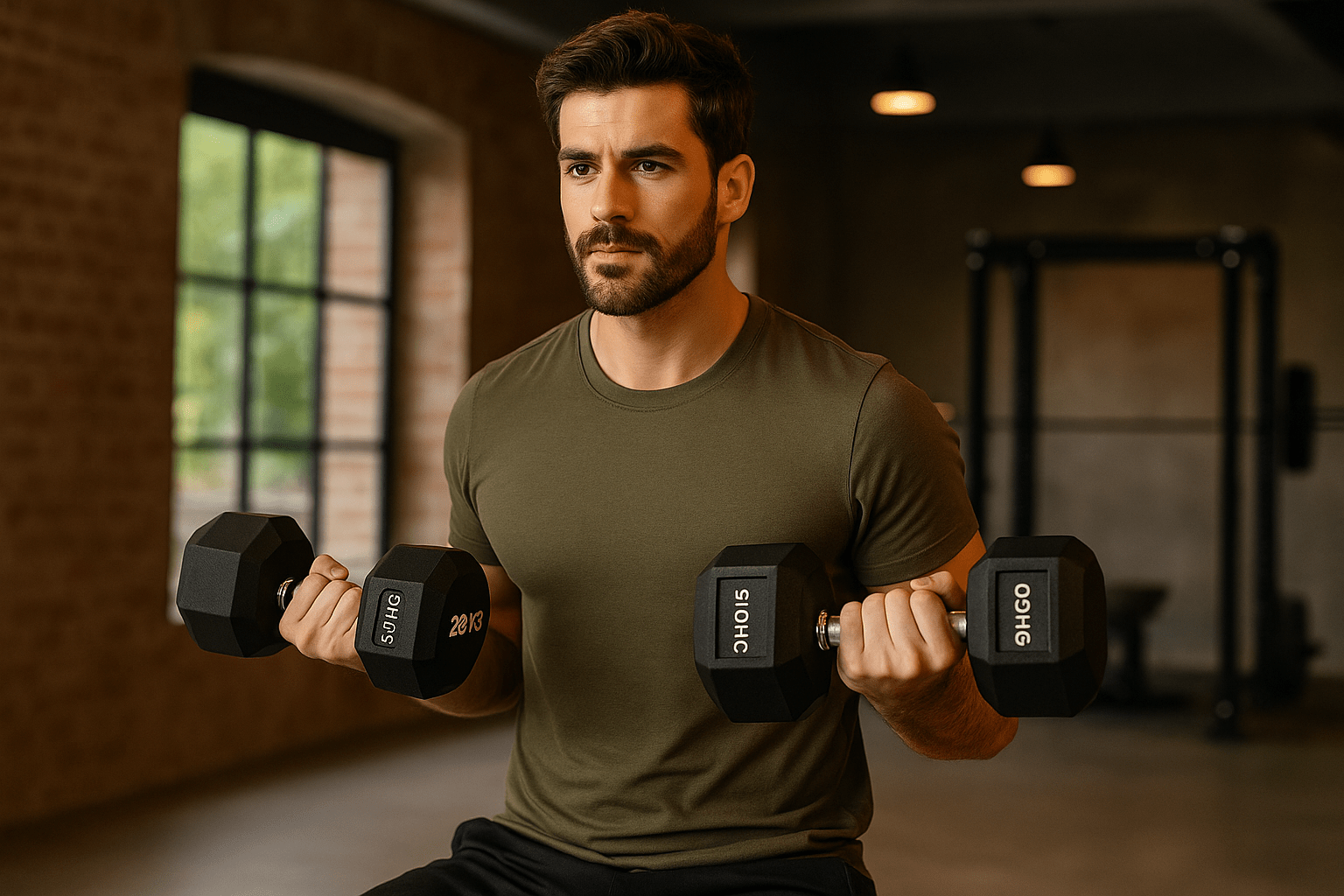
When I first got into weight training, I made the classic mistake — I bought a pair of heavy dumbbells right away, thinking that lifting big from day one would fast-track my gains. What actually happened? Terrible form, sore wrists, and a shoulder strain that had me out of training for weeks.
That’s when I realized something most men ignore in the beginning: dumbbells aren’t just about how much you can lift — they’re about how you use them. And sometimes, the smallest dumbbells in the room can be the ones that make the biggest difference.
Over the years, I’ve built a small collection of dumbbells at home. From light neoprene pairs I use for warm-ups and high-rep conditioning, to heavy hex dumbbells that test my strength, to adjustable ones that save space while giving me multiple weight options. Each type has its role, and together they make home workouts versatile and effective.
This guide is everything I’ve learned about dumbbells — why they’re essential, how to choose the right ones, and my experiences with four sets that I believe cover the full spectrum for any man building strength at home.
Why Dumbbells Are Essential for Men’s Training
You can have a fancy gym membership, a bench press setup, or even resistance bands, but if there’s one piece of equipment that’s truly timeless and irreplaceable, it’s dumbbells.
Here’s why:
- Versatility: With dumbbells, you can train every muscle group — chest presses, shoulder raises, curls, squats, lunges, rows. One tool, full-body potential.
- Natural Range of Motion: Unlike barbells or machines, dumbbells let your joints move more freely. This means less stress on your shoulders and elbows, and more natural movement patterns.
- Balance & Stability: Because each arm works independently, dumbbells expose weaknesses. If your left arm is weaker, you’ll know — and you’ll fix it.
- Space-Friendly: A few pairs of dumbbells can replace entire racks of machines. Perfect for apartments and home gyms.
- Progression Made Simple: Start with light ones, build form, then move to heavier sets. Add variety by changing reps, sets, and exercises.
Whenever someone asks me what they should buy first for a home gym, my answer is always the same: start with dumbbells.
Starting Light: Why Beginners Must Begin Small
When you’re just starting weight training, the temptation is to grab the heaviest dumbbell you can lift. I know because I did exactly that. But here’s the truth most men figure out the hard way: your muscles might handle it, but your joints, tendons, and form won’t.
Starting with light weights isn’t about being “weak.” It’s about:
- Learning form the right way: Shoulder presses, chest presses, curls — they all look simple until you try to control them with a heavy dumbbell. Lighter weights let you focus on the movement, not just surviving the lift.
- Preventing injury: A bad rep with 5 kg might just feel awkward. A bad rep with 20 kg can put you out of training for weeks.
- Building the mind-muscle connection: It sounds cliché, but you’ll get stronger faster if you can actually feel the right muscles working. Light weights teach control.
- Gradual progression: Every guy wants to “level up” fast. But trust me, nothing feels better than looking back in a year and realizing that the weights you once struggled with are now your warm-up.
When I train beginners, I always tell them: start with light dumbbells, master your form, then progress. Heavy lifting comes later — and it feels far more rewarding when you earn it.
The Role of Light Weights Even for Advanced Lifters
Here’s the twist most men don’t realize: even after you’re pushing 20–25 kg dumbbells, you’ll still find yourself reaching for the 2 kg, 5 kg, or 10 kg pairs.
Why? Because light weights never stop being useful.
- Warm-Ups: Every good workout starts with lighter sets to activate muscles. You can’t just pick up 24 kg cold and expect your shoulders to be ready.
- High-Rep Burnouts: Sometimes, I’ll end my chest workout with sets of 30 reps using light dumbbells. The pump and endurance benefits are insane.
- Rehab & Recovery: After injuries, heavy weights are off-limits. Light dumbbells keep you moving while your body heals.
- Shoulder Health: Even pros do lateral raises with 5–10 kg dumbbells. Shoulders are fragile — lighter weights are the secret to keeping them strong and mobile.
- HIIT & Conditioning: For cardio-style workouts or fat loss circuits, light dumbbells let you combine movement and resistance without killing your form.
That’s why I never regret buying my KAKSS neoprene set. Even though I can push much heavier weights now, those small dumbbells still get used weekly — whether for a warm-up, burnout, or a quick workout on a rest day.
Why Build a Collection of Dumbbells
When I first set up a small workout corner at home, I thought one good pair of dumbbells would be enough. Over time, I realized that different weights serve different purposes. Now, I see dumbbells like tools in a toolbox — you wouldn’t use a hammer for every job, and you shouldn’t rely on just one dumbbell set either.
Here’s why building a collection makes sense:
- Warm-up vs Strength Work: A 2 kg dumbbell is perfect for shoulder warm-ups. A 20 kg dumbbell is what I need for chest presses. Both have their place.
- Progressive Overload: Your muscles adapt fast. What feels heavy today will feel light in a few months. Having a range of dumbbells keeps your training challenging.
- Different Goals, Different Weights: Some days I want a slow, heavy strength session. Other days it’s about speed and conditioning. For one, I use heavier fixed dumbbells; for the other, light neoprene ones.
- Family or Partner Training: If you share your space, you’ll quickly realize not everyone can or should lift the same weights. Having a mix means everyone can train.
- Longevity: As you age, your training needs change. Lighter dumbbells might become more useful for mobility and rehab.
I like to think of my dumbbell collection as layers. The neoprene set for warm-ups and HIIT, the adjustable set for daily use, and the heavy hex dumbbells for strength days. Together, they cover every situation without me needing a fancy gym.
Types of Dumbbells Explained
Not all dumbbells are created equal. Understanding the main types helps you choose what fits your space, goals, and budget.
1. Fixed Dumbbells (Hex or Round)
- What they are: Solid dumbbells with a set weight, often coated with rubber for durability.
- Pros: Durable, stable (hex ones don’t roll away), simple to use.
- Cons: You need multiple pairs for different weights, which takes space.
- Best for: Guys who train regularly and want reliable, no-fuss equipment.
2. Adjustable Dumbbells (Plate-Loaded or Dial Systems)
- What they are: A single dumbbell handle where you can add or adjust weight plates, sometimes with a quick dial system.
- Pros: Space-saving, versatile, replaces multiple pairs.
- Cons: More moving parts = more expensive and sometimes less durable than fixed ones.
- Best for: Home gyms with limited space, men who want progressive overload without buying 10 different pairs.
3. Neoprene or Vinyl Dumbbells
- What they are: Lightweight, usually coated in neoprene or vinyl, often colorful.
- Pros: Comfortable grip, great for light training, don’t damage floors.
- Cons: Weight range is limited — not for heavy lifting.
- Best for: Beginners, warm-ups, HIIT, or mobility training.
4. Premium Adjustable Dumbbells (High-Range, Quick Adjust)
- What they are: Advanced versions of adjustable dumbbells with wide weight ranges and fast-change mechanisms.
- Pros: Replace entire racks, sleek design, easy to adjust.
- Cons: Pricey, and you need to handle with care.
- Best for: Serious lifters who want heavy options at home without building a full gym.
My Experience with 4 Dumbbell Sets
1. Slovic Dumbbell Set (Fixed Hex Rubber, 20kg Pair)
The first proper dumbbell set I invested in was the Slovic fixed hex pair — 20 kg each. These feel solid in your hands, like the kind of dumbbells you’d see in a serious gym. The rubber coating keeps them from slipping, and the hex shape means they don’t roll around the floor — which sounds like a small thing, but trust me, you’ll appreciate it when you’re mid-set and don’t want weights sliding under your feet.
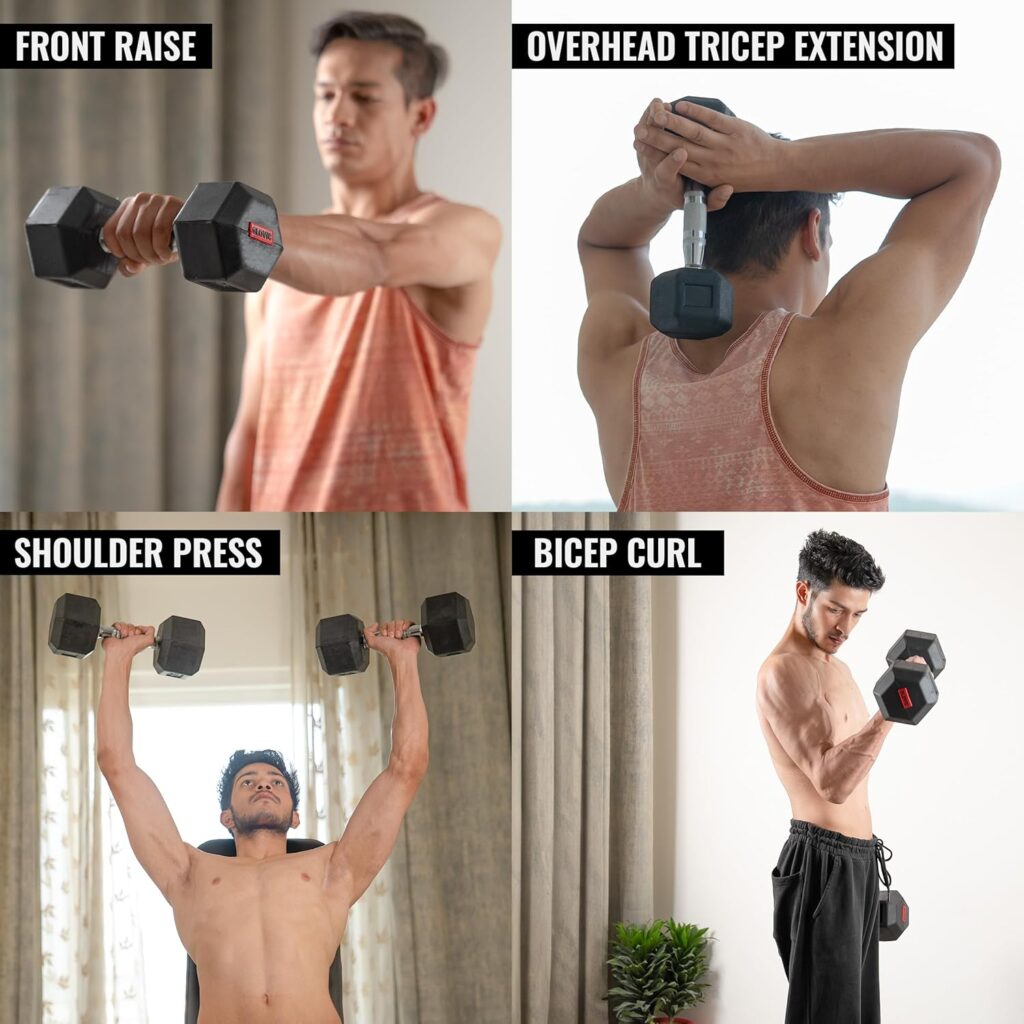
I mainly use these for heavy pressing movements: dumbbell bench press, floor press, and goblet squats. The weight feels right for building strength, and there’s no fiddling around with plates or adjustments — just pick them up and go.
The downside? They take up space. If you want different weights, you’ll need to buy more pairs, which isn’t practical for small apartments. But as a foundation piece of equipment, these dumbbells are rock-solid.
Who it suits best: Men who want heavy, reliable dumbbells for strength training at home, and don’t mind the space trade-off.
2. Lifelong Adjustable Dumbbell (1.5kg – 16kg)
I picked this one up when I realized I needed more flexibility without buying ten different pairs of dumbbells. The Lifelong adjustable dumbbell lets you change weights from 1.5 kg all the way to 16 kg. It’s basically a single dumbbell that doubles as a whole set.
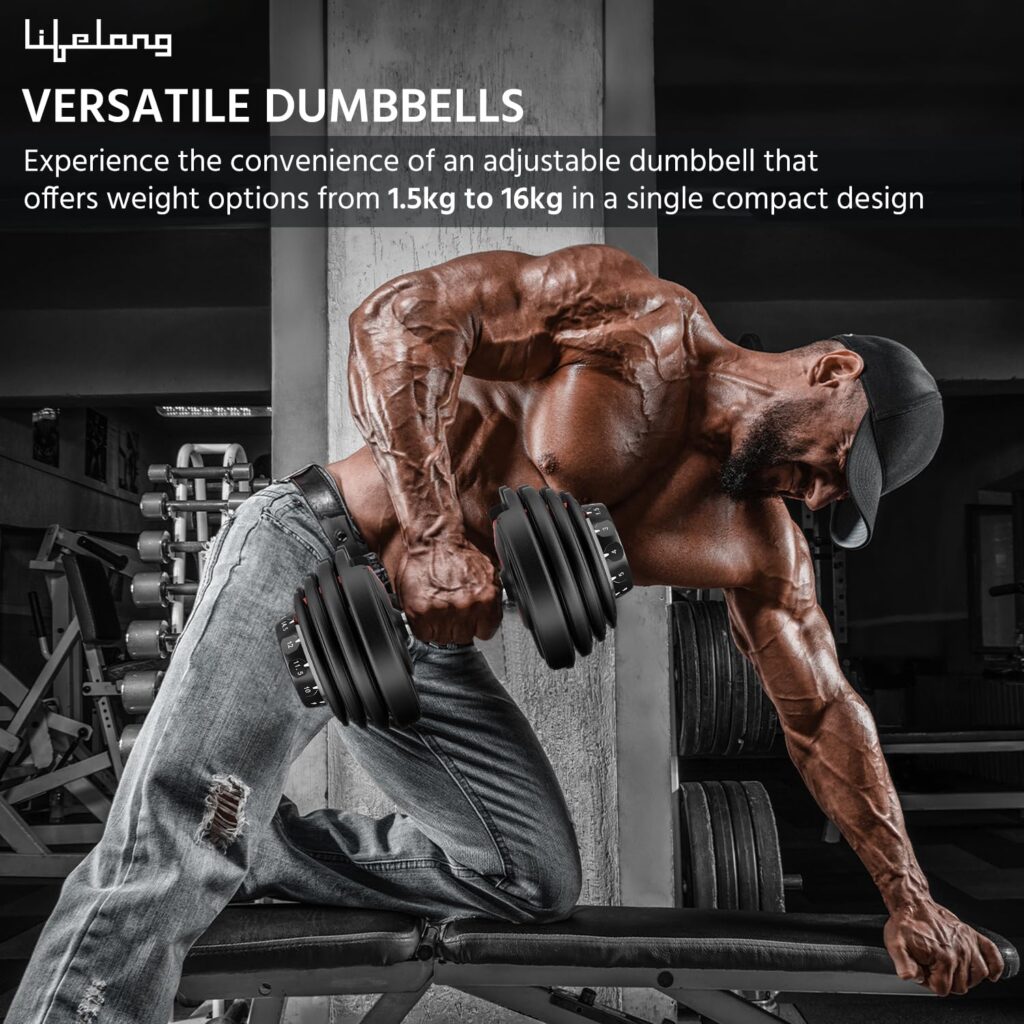
The first time I tried it, I was impressed by how easy it was to switch between weights. I used the lighter setting for warm-up shoulder raises, then cranked it up for curls and rows. The grip is decent, though not as premium as the Slovic hex set.
Where this shines is for guys with limited space. I live in a compact place, and I can’t have a whole rack of dumbbells. With this, I can get multiple workouts done with just one piece of gear. The only catch is that the top-end weight (16 kg) might not be enough once you’re lifting seriously heavy. But for most men starting out, it covers a wide range.
Who it suits best: Beginners or intermediate lifters who want versatility in a small space.
3. XRT65 Adjustable Dumbbell Set (2.5kg – 24kg, Pair)
This is the upgrade I didn’t know I needed. The XRT65 set goes from 2.5 kg all the way up to 24 kg, and it comes as a pair, which instantly made it feel like a serious home gym setup.
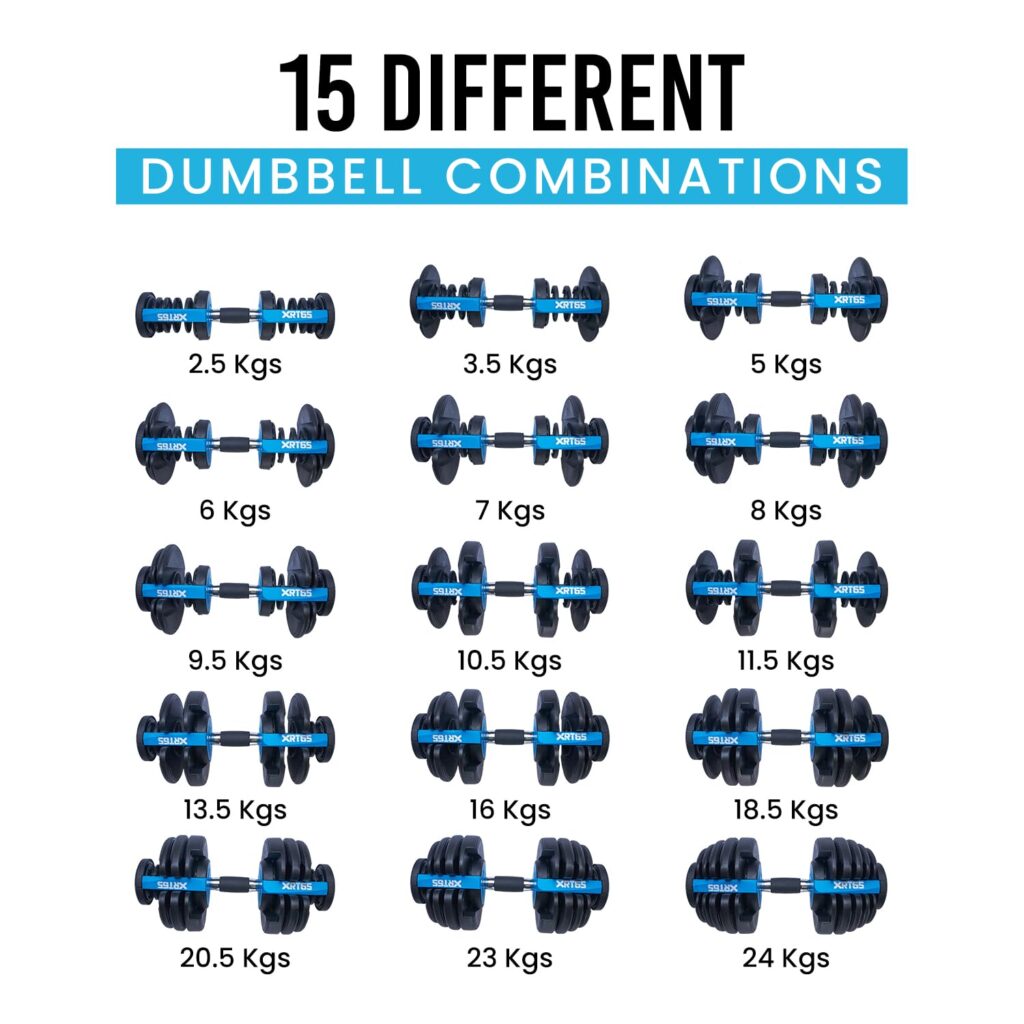
The design is sleek, the grip is comfortable, and the quick adjustment system actually works without hassle. The first time I tried them, I did a full workout without once thinking, “Man, I wish I had another pair.” From curls to shoulder presses to squats, the range was more than enough.
Yes, they’re expensive compared to other options, but if you think about what it would cost to buy separate dumbbells in every weight range up to 24 kg, it actually makes sense. The one thing to be careful with is durability — these aren’t meant to be dropped around like old-school iron dumbbells. But if you treat them well, they’ll last.
Who it suits best: Men who want a premium, all-in-one solution that replaces a full dumbbell rack.
4. KAKSS Neoprene Dumbbell With Stand (0.5kg – 1.5kg Pairs, 6kg Total)
I bought this one almost as an afterthought — and now I use it more often than I expected. The KAKSS neoprene set comes with 0.5 kg, 1 kg, and 1.5 kg pairs, and a stand to keep them tidy. They’re colorful, light, and easy to grab for quick sessions.
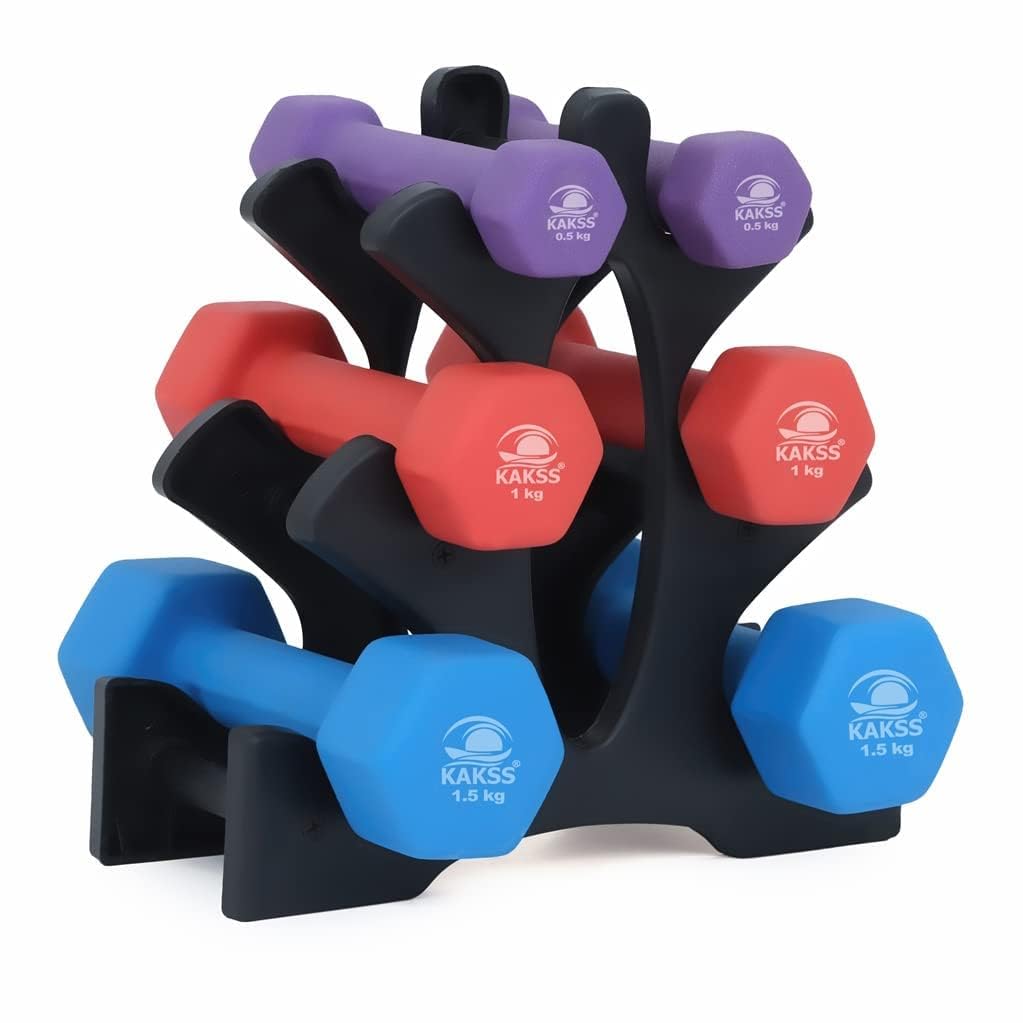
At first, I thought they’d be too light to matter. But then I started using them for warm-ups, mobility drills, and high-rep burnout sets. After a heavy chest day, grabbing the 1.5 kg pair and repping out 30–40 lateral raises is brutal in the best way. They’re also great for cardio circuits, where you don’t want heavy weights slowing you down.
The neoprene coating feels good in the hands, and they don’t damage floors. They’re not for heavy lifters who want to build mass, but as part of a collection, they’re surprisingly valuable.
Who it suits best: Beginners starting light, and advanced lifters who need warm-up or burnout weights in their collection.
How to Use Dumbbells in Daily Training
When people ask me if dumbbells alone can build muscle, my answer is always yes. You don’t need fancy machines to get stronger — you just need to know how to use what you have.
Here’s how I work dumbbells into different training styles:
Full-Body Strength Training
- Chest Press / Floor Press: Lie on the floor or a bench and press heavy dumbbells for chest development.
- Shoulder Press: Seated or standing, great for building strong shoulders.
- Rows: Bend forward and pull dumbbells toward your chest — works the back like nothing else.
- Squats & Lunges: Hold dumbbells at your sides or on your shoulders. Adds serious resistance to leg day.
Conditioning & Fat Loss
- Dumbbell Thrusters: A squat combined with an overhead press — brutal for conditioning.
- Renegade Rows: Push-up + row combo that torches your core.
- Farmer’s Carries: Grab heavy dumbbells and walk — simple, effective, exhausting.
- High-Rep Circuits: Lighter dumbbells, fast pace, minimal rest.
Warm-Ups & Rehab
- Lateral Raises with 1–2 kg: Perfect for activating shoulders.
- External Rotations: Keeps your rotator cuff strong, especially if you lift heavy.
- Mobility Drills: Adding light dumbbells makes them more effective.
The beauty of dumbbells is that they grow with you. As a beginner, you’ll use them for learning movements. As an advanced lifter, they’ll still be part of your heavy strength work or recovery days.
Common Mistakes Men Make with Dumbbells
Over the years, I’ve seen the same errors again and again. I made most of them myself.
- Going Too Heavy Too Soon
Ego lifting is real. You grab the heaviest dumbbells you can find, and your form goes out the window. Instead of building muscle, you build injuries. - Ignoring Form
A curl isn’t just swinging weights up and down. A press isn’t just moving weight overhead. Small details — elbow position, shoulder stability, wrist alignment — make all the difference. - Not Balancing Both Sides
With dumbbells, each arm works independently. If you always rush through, you might let your stronger side dominate, which leads to imbalances. - Skipping Warm-Ups
Jumping straight into heavy lifts without warming up shoulders and joints is asking for trouble. Those tiny neoprene dumbbells? That’s what they’re for. - Neglecting Lower Body
Many guys think dumbbells are just for chest and arms. But some of the best dumbbell exercises are for legs: lunges, Bulgarian split squats, goblet squats. - Sticking to the Same Weight Forever
If you’ve been using the same 10 kg dumbbells for a year, don’t be surprised if your progress stalls. Progressive overload is the name of the game — you need to increase weight or reps.
Fixing these mistakes doesn’t just prevent injuries — it actually makes your training more effective and satisfying.
Who Needs What (Breakdown by Lifter Type)
One of the biggest mistakes I made early on was assuming one dumbbell set could do it all. The truth is, the “best” dumbbell depends on where you are in your fitness journey and what your training looks like.
Here’s how I’d match the four sets we’ve been talking about:
For Beginners
If you’re just starting weight training, don’t rush into heavy weights. Start light, focus on your form, and build confidence. The KAKSS neoprene dumbbell set is perfect here. You’ll have a range of very light weights, which are ideal for learning movements, warming up, and even for cardio-style workouts. Once your form is solid, you can move up.
For Men with Limited Space
If you live in an apartment or don’t want multiple dumbbells lying around, the Lifelong adjustable dumbbell (1.5–16 kg) makes sense. It covers most beginner to intermediate exercises, and you only need one piece of equipment.
For Intermediate Lifters
Once you’re past the beginner stage, you’ll want heavier dumbbells that feel solid in your hands. The Slovic fixed hex dumbbell set (20 kg each) is built for this. You can press, squat, and row these for serious strength. They’re reliable, durable, and feel like gym equipment.
For Advanced Lifters & Home Gym Builders
If you’re serious about lifting and want something that grows with you long-term, the XRT65 adjustable dumbbell set (2.5–24 kg, pair) is the best choice. It replaces an entire rack of dumbbells and covers a wide range of exercises. It’s an investment, but one that makes sense if you’re training regularly.
For Collectors & All-Rounders
The truth? Many men end up building a small collection — a light set for warm-ups, a mid-weight pair for everyday workouts, and a heavy set for strength days. Each one plays a role, and together they give you a complete training toolkit.
Quick Comparison Table
| Dumbbell | Type | Weight Range | Best For | Why I’d Pick It |
|---|---|---|---|---|
| Slovic Fixed Hex | Fixed Rubber | 20 kg pair | Intermediate lifters | Heavy, durable, reliable for strength work |
| Lifelong Adjustable | Adjustable (plate system) | 1.5–16 kg | Beginners, small spaces | One dumbbell, multiple weights, affordable |
| XRT65 Adjustable | Premium Adjustable | 2.5–24 kg (pair) | Advanced lifters, home gym builders | Replaces a whole rack, sleek design |
| KAKSS Neoprene Set | Neoprene Coated | 0.5–1.5 kg pairs (6 kg total) | Beginners, warm-ups, HIIT | Comfortable grip, light, perfect for form and cardio |
With dumbbells, it’s not just about lifting heavy — it’s about having the right weight for the right purpose. Whether you’re starting out, training in a small space, or building a full home gym, there’s a set that fits your needs. And if you’re anything like me, you’ll eventually end up with a small collection — because every weight, light or heavy, has its role.
